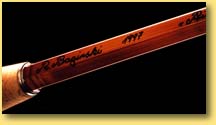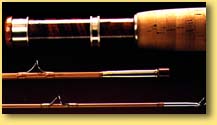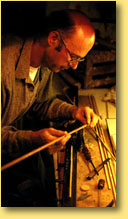| Tonkin - the naturally grown "feeling"
More than 1000 kinds of Bamboo are known to science - but only one is uniting all characteristic qualities for the production of split-cane-rods - "arundinaria amabiles" - the "lovely grass" as it was named by F.A. McClure. This particular species, also known as Tonkin-cane, is growing exclusively in China and there especially in the coastal regions of Kwangsi and Kwangtung. Only here in these areas we find the climatic conditions to guarantee the growth of this grass - many times shaken and whipped by monsoon-storms - to make it suitable for the building of split-cane-rods. |

After cutting the stems, which can reach a height of up to 12 meters, they have to be transported to the river Sui from where they are, after a pre-drying-procedure, transported on the waterway to to twon of Fetchung. In Fetchung the stems are dried over fire, which gives them the characteristic "straw"-yellow colour. Finally they are bundled and shipped from Hongkong reaching Europe and other overseas markets.

|
| Reel-Seats Manually produced split-cane-rods are a speciality, each one unique and valuable.

This refers as well to my wooden reel-seats made from selected and rare Amboina wood, which shows in its roots phantastic speckled/velned wood-structures. Like my rods also the reel-seats are hand-made and manually fitted. Each reel-seat is unique and completes your rod to an exclusive and individual preciousness.
Other kinds of wooden spacers available.

|
| The manufacturing process |
 |
Principally there are two different treatments of the raw-material:
- Sawing and milling by machines
- Splitting and planing manually
|
| By using the first mechanized method, the cane is sawn into individual sections and single splices are milled. This results in the disadvantages that the naturally grown directions of the fibres and especially the knots between the individual sections will be damaged.
By using the second manual method, which is absolutely essential to produce a first-class rod, the Tonkin-cane is split manually along the natual direction/running of the fibres to achieve the raw splices. During the following production-procedure the splices are straightend and adjusted as well as planed manually until the final shape is achieved, i.e. that the "power"-fibres of the cane are perfectly straight and consequently can fulfil the desired function.
The production of the rod by the manual method i.e. from the raw Tonkin-cane to the completed split-cane-rod, needs more than 200 different working steps, which means a total of about 40 to 60 working hours.
For all my rods I personally guarantee:
- the cane is neither sawn nor milled!
- all splices for one rod are from the same Tonkin-cane only!
- all splices are re-assembled in the same way as they were split out of the Tonkin-cane!

|
| The finish Naturally an exclusive rod should not only be perfectly manufactured and cast the fly-line in an excellent manner, it also has to show this with its visual appearance.
The first of all needs an outstanding lacquer-finish. My rods have a triple dipcoat-lacquering with a lacquer which is especially suitable for split-cane-rods.

The guides are fixed to the rod by the finest British silk-threads. The special lacquering of the silk-windings results in an elegant transparency and colour.
Fittings/ bushings/ ferrules are made from valuable precision-drawn Germansilver/Argentine, manually ground, polished and fitted.
The cork for the handle completes the overall quality of a rod. For my handles I select only the best out of thousands of cork-discs.
As such an outstanding product deserves suitable means for transportation there are exclusive handmade leathertubes available.

|
